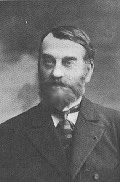
Generally speaking, the Greek scholar Eratosthenes, who measured the circumference
of the earth and who was the first to use the word "geography," is
called the father of geography.
During the 1800s, the era of colonization and opening up to new civilizations
and ideas, many geographic societies emerged. Geographic studies and explorations
were sponsored and geographic journals were published. Geographic societies
were founded, the earliest ones in Paris, Berlin, and London, during the 1820s
and 1830s. In the United States the American Geographical Society was the founded
of in 1851 and the National Geographic Society in 1888. International geographic
conferences were initiated in 1871 at Antwerp, Belgium.
During that century the dominant axes of geography were laid by three outstanding
men: Alexander von Humboldt commonly called the "father of modern geography",
William Morris Davis the "father of American geography" and Vidal
de la Blanche called the « father of French geography. »
Nowadays, we find that all geographies strive towards the same goals within
the different cultural contexts, though one has to be aware that the origins
of each one are not the same. German and English Geography is mostly influenced
by natural sciences, French Geography is coming from a more social scientific
approach.

English Geography is strongly influenced by the American scientist William
Morris Davis. He specialized in geomorphology and physical geography. Geomorphology
is the study of the earth's landforms. William Morris Davis was the founder
of this section of geography.
At the end of the 19th century the traditional idea of the development of landforms
was still influenced by the great biblical flood. Due to the new vision of the
structures of our earth, Davis (as well as Humboldt, Ritter etc.) began to believe
that other factors were responsible for shaping the earth. He developed a theory
of landform creation and erosion, known as the "cycle of erosion."
This theory explained that landforms and mountains are created, mature, and
then become old. His theory was rather revolutionary and exceptional at its
time (even though not quite accurate – the real world is not as systematic,
since erosion occurs also during the creation process) and helped to modernize
physical geography as well as create the field of geomorphology.
In the early 1800s, Alexander von Humboldt and Carl Ritter made major contributions to geographic theory. Being a brilliant
field observer, Humboldt applied his knowledge of physical processes to the
systematic classification and comparative description of geographic characteristics,
which he observed in the field during his extensive travels. He worked out systematic
approaches to determine the physical features he repeatedly observed. Humboldt
wrote a number of outstanding geographic studies based on his travels in America.
In 1844 he published “Kosmos”, describing the physical geography
of the earth. It is considered one of the greatest geographic works ever.
and Carl Ritter made major contributions to geographic theory. Being a brilliant
field observer, Humboldt applied his knowledge of physical processes to the
systematic classification and comparative description of geographic characteristics,
which he observed in the field during his extensive travels. He worked out systematic
approaches to determine the physical features he repeatedly observed. Humboldt
wrote a number of outstanding geographic studies based on his travels in America.
In 1844 he published “Kosmos”, describing the physical geography
of the earth. It is considered one of the greatest geographic works ever.
Ritter partially shared the views of Humboldt, but he adopted a more regional
approach to geography. He stressed the comparative study of particular areas
and the features that characterize those areas. Ritter was an eager field observer,
well trained in natural sciences and history. He called his work comparative
geography, considering it similar to comparative anatomy, and proceeded from
observation to observation to arrive at laws and principles. Ritter also  believed
that without systematic studies regional studies would be impossible. In 1859,
he published “Geography and Its Relation to Nature and the History of
Man”, which is an excellent geographic analysis of Asia and parts of Africa.
believed
that without systematic studies regional studies would be impossible. In 1859,
he published “Geography and Its Relation to Nature and the History of
Man”, which is an excellent geographic analysis of Asia and parts of Africa.
In 1882, Friedrich Ratzel published the “Anthropogeographie”. He
tried to prove that the distribution of people on the earth had been determined
by the environment. He believed that studying dertermined areas would allow
for conclusions and generalizations about other or larger areas, as well as
about the whole world.
In 1927, Alfred Hettner published the book: “ Geography: Its History,
Its Nature, and Its Methods.” He tempted to bring these three approaches
together, making it an important contribution to the development of geographic
methodology.
French Geography emphazes human geography. Its father is P. Vidal de La Blache.
 Vidal's
influence on the discipline has gone beyond national and international borders
and has persisted over time. Geography has probably never been influenced so
much by an individual person.
Vidal's
influence on the discipline has gone beyond national and international borders
and has persisted over time. Geography has probably never been influenced so
much by an individual person.
Vidal stressed the importance in setting man in relation to his natural environment.
He viewed man within a physical milieu, which he described as “pays”,
or within his cultural milieu, described as “genre de vie”. A “pays”
is a natural region with some uniform physical characteristics, for example
the mountainous Massif Central region in France. A “genre de vie”
is a way of living, including traditions, institutions, languages (dialects),
habits, foods, etc. of a people. To put it differently, when one observes a
particular area, one may see its physical as well as its human caracteristics
with regard to their relationships.
Environmental determinism, being one of the major geographical doctrines of
his time, examined this man-land relationship with respect to regions. It stressed
the effects of causal relationships whereby human action was limited by the
environmental factors.
Vidal’s countered this doctrine with the idea of “Possibilism”.
He acknowledged that the local environment provides the possibilities for cultural
and personal development, though pointing out that humans can intellectually
respond differentiated in numerous ways to one and the same given situation.
These choices are manifested in a people’s culture, or “genre de
vie”. Thus, possibilism is seen as an alternative to environmental determinism,
explaining how humans respond to their environment is partialy due to the location
and partly a function of their own will.